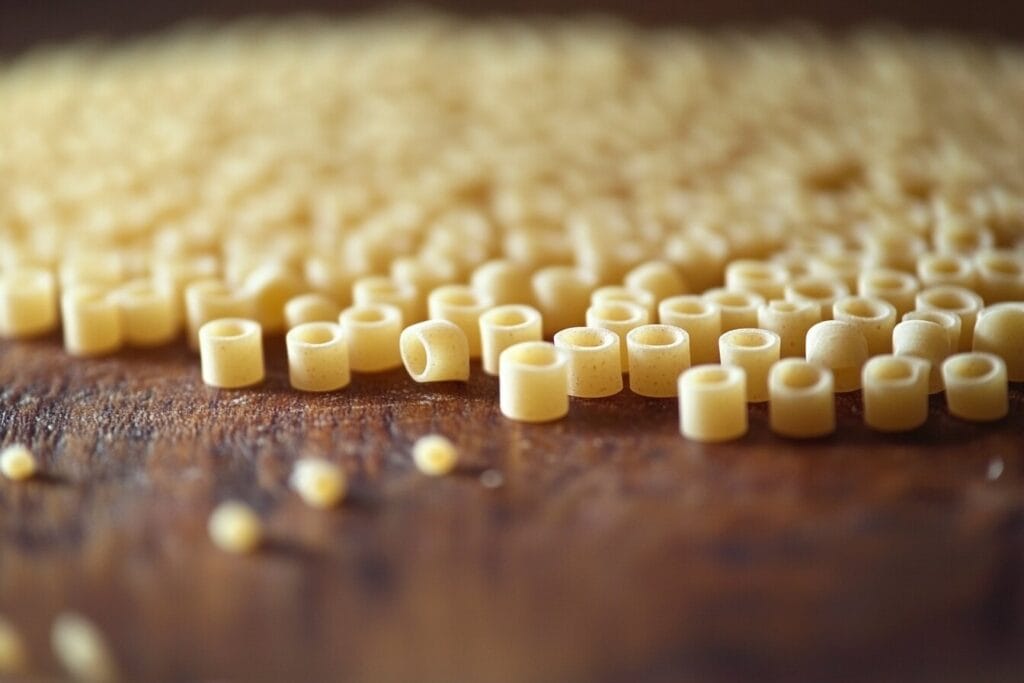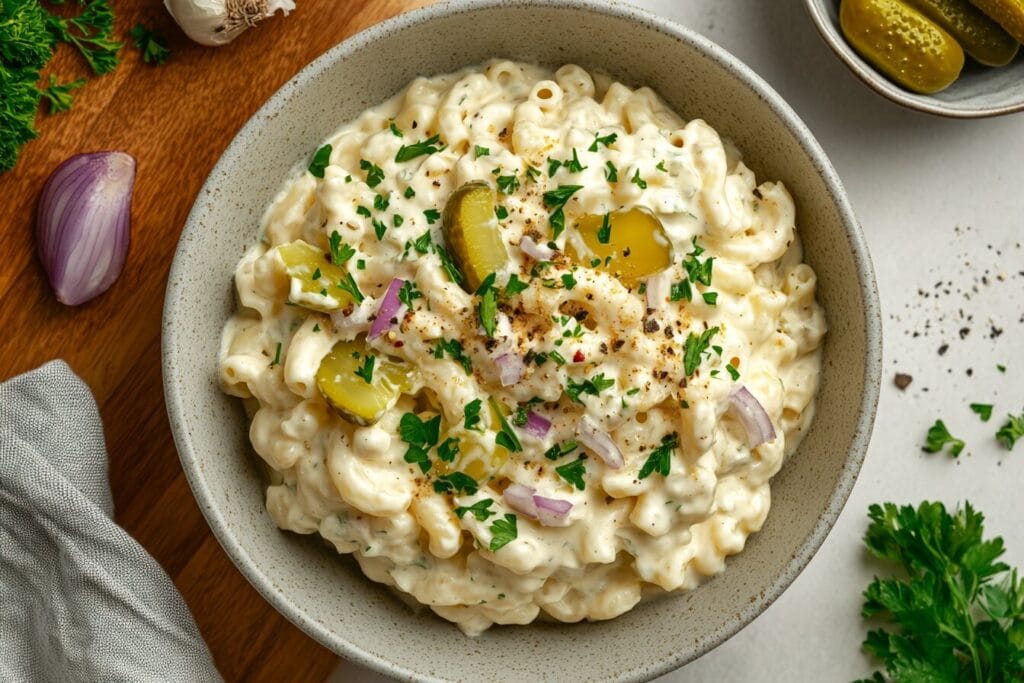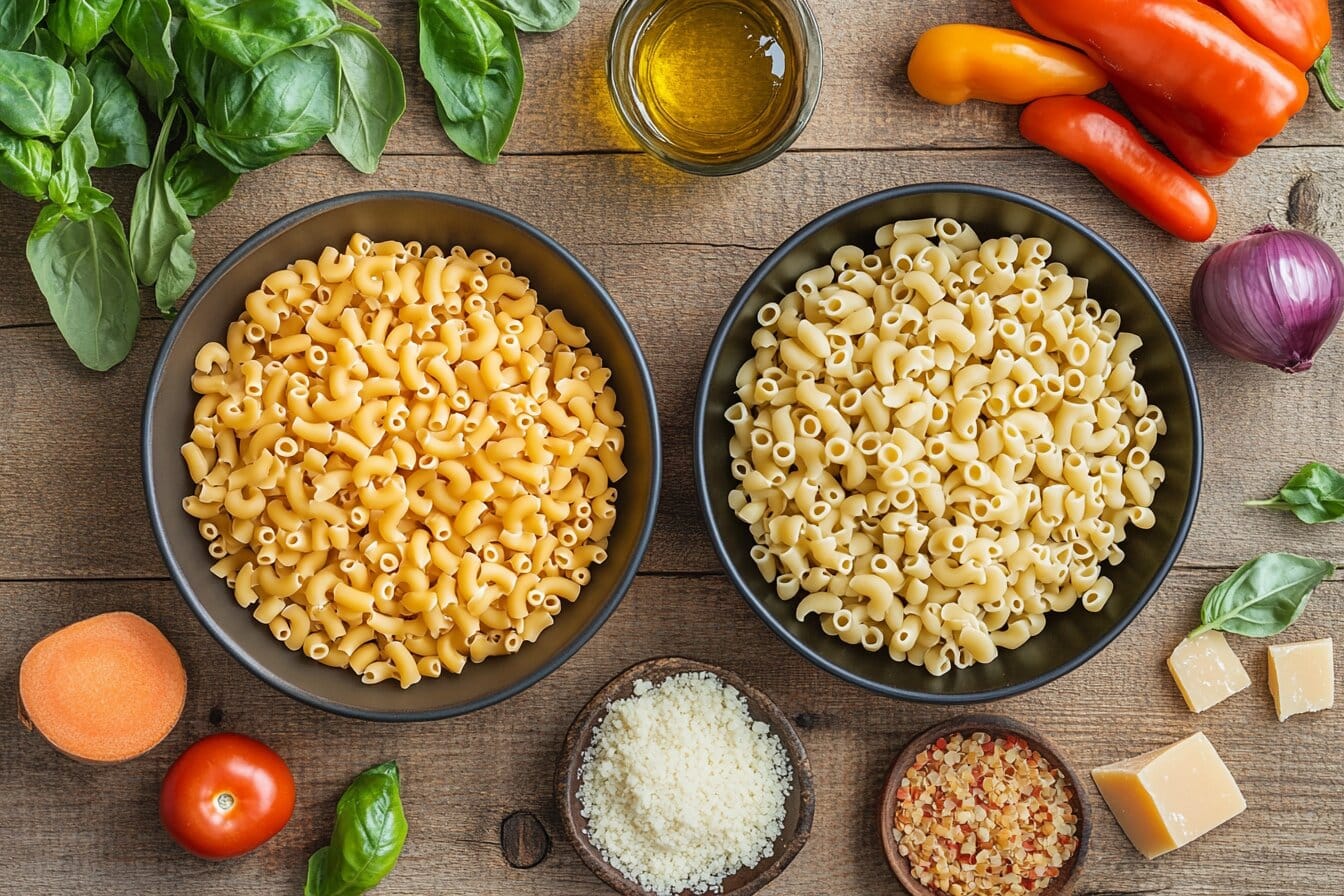Pasta lovers, this one’s for you! You’ve probably seen a dozen shapes of pasta on grocery store shelves, each more mysterious than the last. And then, there are the tiny, tubular ones like ditalini and salad macaroni. They might look alike at first glance, but are they really the same? Let’s break it down and uncover the tasty secrets of these two pasta types!
Understanding Ditalini and Salad Macaroni
To truly grasp the similarities and differences between ditalini and salad macaroni, we need to know what each brings to the table—literally!
What Is Ditalini?
Ditalini is the ultimate multitasker in the pasta world. Its small, thimble-like shape makes it a perfect addition to hearty soups, broths, and stews. But don’t let its size fool you—ditalini packs a punch!
Why is it so popular? Simple. Its small size allows it to absorb flavors beautifully, and its hollow center catches just the right amount of sauce. Imagine a spoonful of soup with soft veggies, flavorful broth, and a tiny pasta piece soaked with all that goodness. Delicious, right?
But ditalini isn’t just for soups. In Italy, it’s affectionately called the “go-to” pasta for simple yet satisfying meals. Toss it with olive oil, garlic, and some grated Parmesan, and you’ve got yourself a weeknight dinner in minutes.

Fun Fact: The name “ditalini” comes from the Italian word “dito” meaning “finger.” The pasta’s shape resembles tiny finger-like thimbles!
What Is Salad Macaroni?
Now let’s talk about salad macaroni, the crowd-pleaser of pasta shapes. If ditalini is the soup expert, salad macaroni is the salad superstar. It’s slightly larger, chunkier, and designed to shine in dishes where creamy textures and bold flavors are the heroes.
Ever had a macaroni salad that seemed like it was missing something? That’s because not all pasta shapes work in cold dishes. Salad macaroni stands out for its ability to hold onto creamy dressings without becoming soggy. Picture this: tangy mayo, crunchy veggies, and perfectly cooked pasta that doesn’t fall apart—sounds like a backyard barbecue dream, doesn’t it?
Salad macaroni also loves versatility. Sure, it’s the darling of macaroni salads, but it also works in casseroles, baked pasta dishes, and even quick stovetop meals when you’re short on time.
Pro Tip: Always rinse salad macaroni under cold water after boiling to stop the cooking process and prevent it from sticking together.
Origins and Culinary Uses of Ditalini and Salad Macaroni
Here’s where their stories diverge.
- Ditalini: Born in the heart of Italy, ditalini is steeped in tradition. Italians use it in soups like minestrone, where every bite tells a story of love and comfort.
- Salad Macaroni: This pasta shape is a homegrown American classic. It’s less about tradition and more about practicality, designed for quick, easy dishes that feed a crowd.
Key Differences Between Ditalini and Salad Macaroni
You might be thinking, “They’re both small and tubular—how different can they be?” Well, let’s take a closer look.
Shape and Size Comparison
Ditalini and salad macaroni are like cousins—they share some features but have distinct personalities.
| Feature | Ditalini | Salad Macaroni |
|---|---|---|
| Shape | Tiny, uniform cylinders | Short, wider tubes |
| Size | Smaller | Slightly larger |
| Use | Soups, stews | Salads, casseroles |
Ditalini’s uniformity makes it ideal for delicate dishes like soups, where precision matters. Salad macaroni, being slightly larger, is better for holding creamy or chunky textures, making it the MVP of pasta salads.
Texture and Cooking Time Differences
Texture is everything when it comes to pasta.
- Ditalini: Soft but firm enough to hold its shape in broth. Cooks in about 7–8 minutes.
- Salad Macaroni: Sturdy and slightly chewy. Takes around 9–10 minutes to cook, which helps it hold up in heavy dressings or baked dishes.
One misstep in cooking either pasta can lead to disaster—a mushy mess or a dish that feels underdone.
Quick Fix: Add a teaspoon of olive oil to the boiling water to prevent sticking and improve texture!
To learn more about pasta types for different recipes, explore What Pasta Is Best for Soup? Discover Expert Tips & Pairings.
Best Dishes for Ditalini vs. Salad Macaroni
Still confused about which to use? Here’s a cheat sheet:
- Ditalini: Think soups, stews, or simple tosses with light sauces. It’s your best friend when you want subtlety.
- Salad Macaroni: Perfect for cold salads, baked dishes, or casseroles with bold flavors. It’s all about standing out.

Common Misconceptions About Ditalini and Salad Macaroni
Why People Confuse Them
It’s easy to see why people get these two mixed up. Both are small, tubular, and often come in similar packaging. But the key is to look closely at the size and shape. Ditalini is more delicate, while salad macaroni feels a bit heftier.
Imagine buying a shirt in the wrong size—it might look fine on the rack but won’t fit quite right. That’s exactly what happens when you swap these pastas in the wrong recipes.
Regional Variations and Naming Confusion
To make matters trickier, pasta names can vary by region or brand. In some places, you might find ditalini labeled as salad macaroni or vice versa. It’s a naming game that can confuse even seasoned cooks.
The solution? Know your pasta shapes. A quick glance at the size and texture can help you make the right choice.
Recipes Featuring Ditalini
Here’s where things get exciting—recipes! Ditalini is incredibly versatile, and these dishes show off its best qualities.
Classic Italian Minestrone Soup
Warm, comforting, and nutritious, minestrone is a celebration of flavors. And ditalini is the unsung hero that ties it all together.
Ingredients:
| Ingredient | Quantity |
|---|---|
| Ditalini pasta | 1 cup |
| Olive oil | 2 tbsp |
| Onion (chopped) | 1 |
| Carrots (diced) | 1 cup |
| Celery (diced) | 1 cup |
| Zucchini (diced) | 1 cup |
| Vegetable broth | 4 cups |
| Canned tomatoes | 1 can (14 oz) |
| Kidney beans | 1 cup (cooked) |
| Salt and pepper | To taste |
Steps:
- Heat olive oil in a pot over medium heat. Sauté onions until translucent.
- Add carrots, celery, and zucchini, cooking for about 5 minutes.
- Pour in the vegetable broth and canned tomatoes, bringing it to a boil.
- Stir in beans and ditalini, reducing heat to simmer. Cook until pasta is tender.
- Season with salt and pepper. Serve hot, topped with grated Parmesan.
Did You Know? Minestrone soup varies by season in Italy, with fresh veggies swapped depending on what’s available.
Ditalini with Tomato Basil Sauce
This recipe is perfect for when you need something quick but satisfying.
Ingredients:
| Ingredient | Quantity |
|---|---|
| Ditalini pasta | 1 cup |
| Fresh tomatoes | 3 (diced) |
| Garlic (minced) | 2 cloves |
| Fresh basil leaves | 5–6 |
| Olive oil | 2 tbsp |
| Salt and pepper | To taste |
Steps:
- Boil ditalini pasta until al dente, then drain.
- In a pan, heat olive oil and sauté garlic until fragrant.
- Add diced tomatoes and cook until softened.
- Toss in cooked ditalini and mix well.
- Garnish with fresh basil and serve with a sprinkle of Parmesan.
Now that we’ve laid the groundwork for understanding ditalini and salad macaroni, let’s dive deeper into their uses, troubleshoot common cooking challenges, and explore more recipes and tips that will turn you into a pasta expert!
Recipes Featuring Salad Macaroni
Cold Mediterranean Macaroni Salad
Looking for a healthy twist on classic macaroni salad? This Mediterranean-inspired version is loaded with fresh veggies, tangy feta, and a zesty lemon dressing. It’s light, flavorful, and perfect for summer picnics or as a side dish.
Ingredients:
| Ingredient | Quantity |
|---|---|
| Salad macaroni | 2 cups |
| Cherry tomatoes (halved) | 1 cup |
| Cucumber (diced) | 1 cup |
| Kalamata olives (sliced) | 1/2 cup |
| Feta cheese (crumbled) | 1/2 cup |
| Red onion (thinly sliced) | 1/4 cup |
| Olive oil | 3 tbsp |
| Lemon juice | 2 tbsp |
| Dried oregano | 1 tsp |
| Salt and pepper | To taste |
Steps:
- Cook salad macaroni until al dente, drain, and rinse under cold water.
- In a large bowl, combine macaroni, tomatoes, cucumber, olives, onion, and feta cheese.
- Whisk together olive oil, lemon juice, oregano, salt, and pepper to create the dressing.
- Pour the dressing over the salad and toss well to combine.
- Chill for at least 30 minutes before serving.
Fun Fact: Adding a pinch of smoked paprika to the dressing gives this salad a unique, smoky kick!
For more tips on perfecting cold pasta dishes, see Should I Rinse Pasta for Cold Pasta Salad?.
Loaded Macaroni Bake
Want something hearty and comforting? This loaded macaroni bake is like a pasta version of a loaded baked potato—oozing with cheese, topped with crispy bacon, and perfect for a cozy dinner.
Ingredients:
| Ingredient | Quantity |
|---|---|
| Salad macaroni | 2 cups |
| Shredded cheddar cheese | 2 cups |
| Milk | 1 cup |
| Butter | 3 tbsp |
| All-purpose flour | 3 tbsp |
| Cooked bacon (crumbled) | 1/2 cup |
| Green onions (chopped) | 1/4 cup |
| Salt and pepper | To taste |
Steps:
- Preheat your oven to 375°F (190°C).
- Cook salad macaroni, drain, and set aside.
- Melt butter in a saucepan, whisk in flour, and cook for 1 minute. Gradually add milk, whisking constantly, until the mixture thickens.
- Stir in 1 1/2 cups of cheese, season with salt and pepper, and mix until melted.
- Combine the cheese sauce with cooked macaroni and transfer to a baking dish.
- Top with remaining cheese, bacon, and green onions. Bake for 20 minutes or until bubbly and golden.
Pro Tip: Swap bacon for diced ham or smoked turkey for a lighter version!
Troubleshooting Common Pasta Problems
Let’s tackle some of the most common challenges when cooking pasta, ensuring you never have a less-than-perfect dish again!
Overcooked or Undercooked Pasta
- The Problem: Pasta is either mushy or too chewy.
- The Solution: Timing is everything. Check your pasta 1–2 minutes before the recommended cooking time. If it’s al dente, drain it immediately.
Quick Tip: If you accidentally overcook your pasta, toss it with a splash of olive oil and bake it in a cheesy casserole to salvage the texture.
Sauce Doesn’t Stick to the Pasta
- The Problem: The sauce slides off, leaving the pasta bland.
- The Solution: Don’t rinse your pasta unless it’s for a cold dish. The starch left on the pasta helps sauces cling better.
Pasta Sticks Together
- The Problem: Your pasta clumps together in one sticky mess.
- The Solution: Stir the pasta during the first few minutes of boiling and add a teaspoon of oil to the water. Drain promptly and toss with sauce or a light dressing to keep it separated.
Storing Pasta the Right Way
Whether you have leftover pasta or want to prep ahead, proper storage is key to maintaining quality.
For Cooked Pasta
- Toss the pasta with a small amount of olive oil to prevent sticking.
- Store in an airtight container in the refrigerator for up to 3–4 days.
- To reheat, add a splash of water or broth to keep it moist and microwave or sauté over medium heat.
For Dry Pasta
- Keep it in its original packaging or transfer it to an airtight container.
- Store in a cool, dry place away from direct sunlight.
Fun Fact: Cooked pasta can also be frozen for up to 2 months. Just thaw in the fridge and reheat gently for best results.
More Tips for Choosing the Right Pasta
The type of pasta you choose can completely transform a dish. Here’s a quick guide to help you decide:
- Soups and Stews: Ditalini, or similar small shapes like orzo or small shells, blend seamlessly with broth and veggies.
- Cold Salads: Salad macaroni, elbows, or small penne hold up well in creamy or tangy dressings.
- Baked Dishes: Heftier pasta shapes like salad macaroni, rigatoni, or ziti work best for retaining texture during baking.
Nutritional Insights
If you’re keeping an eye on your health, knowing the nutritional profile of your pasta is helpful. Here’s a comparison to guide your choices:
| Nutrient | Ditalini (per cup) | Salad Macaroni (per cup) |
|---|---|---|
| Calories | 200 | 210 |
| Protein | 7g | 6g |
| Fiber | 2g | 2g |
| Carbs | 42g | 43g |
| Iron | 10% DV | 8% DV |
While both pastas are nutritionally similar, the key lies in how you prepare them. For a healthier option, consider adding fiber-rich veggies or lean proteins to your pasta dishes.
Final Thoughts
So, is ditalini the same as salad macaroni? The answer is no, but both have their own unique roles in the pasta world. Whether you’re making a comforting soup, a refreshing salad, or a cheesy baked dish, understanding the differences will help you choose the right pasta for the job.
Next time you’re in the pasta aisle, don’t just grab whatever’s closest—take a moment to consider your recipe. The right pasta can elevate your dish from good to absolutely unforgettable.
What’s your go-to pasta dish? Share your thoughts below and let’s swap recipes!

